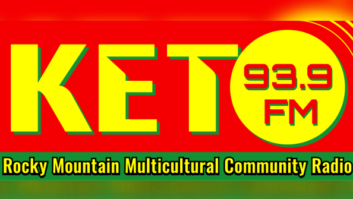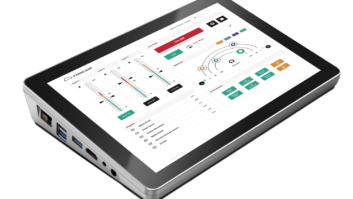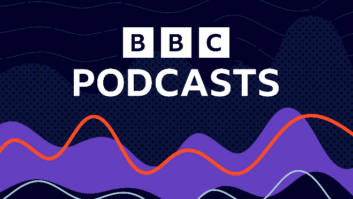
Lockwood on a Qatar Coast Guard tower at Al Aish Qatar. He was helping with electromagnetic compatibility issues caused by proximity to a 2 MW medium-wave station about a mile away. The AM antenna system was designed by duTreil Lundin & Rackley /Hatfield & Dawson Joint Venture and constructed by Harris Broadcast. SEATTLE — Stephen S. Lockwood is a senior professional engineer and a partner with Hatfield & Dawson Consulting Engineers; his communications career has spanned more than 28 years. He works on both AM and FM engineering projects but specializes in AM, and is slated to take part in a session at the upcoming Radio Show about AM technical solutions to revitalize the senior band.
Radio World News Editor/Washington Bureau Chief Leslie Stimson caught up with him after he had returned from a quick trip to California to help a client, a power plant under construction near an AM station.
RW: What’s going on in California?
Lockwood: If you put up a construction crane near AM stations, the end of it will give you a pretty good arc. That tends to make the people working around it somewhat upset. So we’ve been working with a power plant from the beginning — helping them work with the AM stations, and also when they’ve had other problems along the way because they’re building right next to the AM station where the field is 10 Volts per meter. There are certain electronics problems that you’d expect to have with interference issues.
I was buzzing down there yesterday because they’re getting ready to finally start spinning the turbines and discovered that they had instrumentation that wasn’t performing the way they thought it ought to. So I went down and performed what Benjamin [Dawson, the company president] calls “consoling engineering.” We patted them on the head and said “We can fix this,” and we showed them the way to solve these problems.
RW: Broadcasters have pulled back from station facility projects during the recession.
Lockwood: I think broadcast has probably been traditionally 60 or 70 percent of our practice. One of things that Benjamin has done over the years is diversify this practice. We have two of our engineers who do nothing but public safety land mobile systems. That diversification has helped us survive the recent unpleasantness.
We do land mobile engineering for public safety systems large and small, as well as for transit agencies, busses and trains. We also do engineering for difficult and complex SCADA systems for utilities. We are also very experienced in in-building radio system design, ranging from jails to the NPR parking garage.
We always seem to have some international work we’re usually doing with the joint venture with Ron Rackley and Ben. [A joint venture formed by duTreil, Lundin & Rackley and Hatfield & Dawson conducts engineering work for the U.S. government’s International Broadcasting Bureau. Since its inception, the Joint Venture has worked on high-power antenna systems that operate on LF (30-300 kHz), MW (300-3,000 kHz), and HF (3 MHz -30 MHz), not only for the U.S. government but for other governments and other providers of high-power radio services worldwide.]
When we do work offshore, especially if it’s in the medium-wave area, we typically do that as a joint venture so we almost always have some project in the Middle East where somebody’s putting in a couple hundred-kilowatt transmitters or designing antenna systems. Those odd projects have really helped us survive. But the nice thing is the phone’s ringing again on the broadcast side. We’re starting to see some additional work there.
RW: In our March 27 issue, Ron Rackley and Ben Dawson made several technical suggestions to the FCC to fix AM; and the question of AM’s future is in prominent industry debate. What should the commission do? Should it eliminate minimum antenna requirements or city of license coverage requirements, for example?
Lockwood: All of these suggestions that Ron and Ben had, those are things that we’ve been talking about here for years. There are many rules that the AM service is saddled with that go back to previous models of broadcasting where we were still trying to protect the Class A stations. I love the Class A stations, they’re wonderful history. And it’s really cool to have a radio station that covers five states at night. …

Stephen Lockwood is a partner at Hatfield & Dawson Consulting Engineers. While he works on both AM and FM engineering projects, he specializes in AM and is slated to speak at the upcoming Radio Show. But the protection of that nighttime contour on adjacent channels … and you look at minimum efficiency and these kinds of rules that came up through the years, were really efforts to try to protect the Class A stations and they were also, more about the restraint of trade during those times than any good engineering practices. They were just trying to keep the other broadcasters out and to keep the value of the existing facilities as high as they possibly [could]. With that said, I think that looking at all of these rules, there’s probably a few others we can add, but probably not as important as the ones that Ron and Ben settled on. …
You look at these rules and loosening them up and giving some flexibility, I think that gives the owners some ability to make some facility improvements and increase their coverage where that makes sense to them but puts them more in control of their license. And it puts them in a situation where they can make decisions based on financial and engineering considerations and coverage considerations versus historical political reasons.
RW: Do you have any hope anything’s going to change?
Lockwood: I’m cautiously optimistic. Many of these rules, I think, 10 years ago if you had wanted to change these rules there were certain [radio] group owners that were still trying to hang onto some of these things to protect their assets, or felt that they protected their assets.
RW: What about analog AM, should it be sunsetted in favor of a digital sunrise?
Lockwood: In general terms, I like that concept, but I look at all of the proposals out there…when I first saw that Channel 5 and 6 discussion I thought it was a neat idea if the world was a perfect world, that’d be great. But once again with those kind of changes, that wholesale change, there’s a real problem because it’s the haves vs. the have-nots. …
The political side of who gets and who doesn’t get is, in my view, the biggest part of the problem. I don’t know how we get through that side of it and keep most everyone happy.
RW: You mentioned diversification. Are you involved in cases where a radio station leases tower space to a wireless company?
Lockwood: We’ve done a lot of that kind of work at all power levels and helped folks through that process. Sometimes it makes sense. Sometimes it doesn’t. One of the things that we have come to appreciate is that it can be done, it just needs to have some thoughtful engineering approach to it. It is often so out of the box for the cellular companies and the types of firms that they hire to do the rigging and installation work that a lot of those folks make mistakes along the way, so it takes a lot of handholding. But once you’re through that process, it can write a nice check [for the station], and continually write that check. It makes quite a difference to some of the facilities that we’ve helped through that process, where, essentially they’ve got enough money coming in off the rental to pay for half of an engineer.
RW: What does the firm do on the public safety and mobile side?
Lockwood: [W]e have work from the cellular companies. Often there’ll be interference disputes between parties and we will go help mitigate those and /or even determine if any of its real. We’ve helped landlords negotiate leases.
In the Pacific Northwest, we have the 100 percent employment program for consulting engineers, and that is, a lot of jurisdictions require a PE stamp on an RF exposure study for a cell site, which is one of those things that we continue to do.
RW: What about instances where the station has signed the contract, and the engineer walks into the transmitter site later to find the cell people have created a mess. Do you have clients who run into that?
Lockwood: Oh yes, and it’s interesting from company to company. The cell companies have gotten so that the companies themselves really have no employees, and they’re all contractors of contractors. There’s no continuity in their site installation or their maintenance.
One of the things we found particularly funny is with AM towers, you have a cell company that will issue an edict and they say “On all of our sites we will have these particular features.”
A few years ago one of the cell companies in Alaska had problems with ice falling off the tower and damaging the transmission lines, so they said, “All of our sites will have ice bridges cover the site.” They did that at the AM site of one of our Alaska clients. They went and got time with the owner, turned the AM stations off and went and installed their ice bridge and grounded out the tower.
RW: You said things were beginning to turn around on the broadcast side. It sounds like stations are spending money on engineering projects again. Are they building new or upgrading? What are some typical AM and FM projects you’re doing lately?
Lockwood: The biggest projects that we have going on right now have been sort of bubbling along for awhile. They’re situations where facilities have been on an STA and/or there’s some sort of move or something like that that has been going along and they’ve just not been funded. Now that things are loosening up a bit we’re getting “go’s” on a number of those projects. But they all are projects that 10 years ago would have been done instantly because of the concern about compliance with regulations and getting off STAs and things like that, depending on the owner, of course.
On the FM side we’re starting to see some movement, some places that have had construction permits loafing along for awhile. People have tried to keep them alive but they didn’t want to spend any money on them. We’re finally seeing some of those either bought or sold and then implemented. In multiple user sites, that usually requires someone else to move, so there’s some system integration issues that need to be taken care of. We’ve probably got half a dozen of those happening right now.
RW: What about HD Radio on the FM side. Are people implementing the power increase?
Lockwood: We have some. I think the [FMs] that were able to do that by walking over and getting their little green screwdriver out and cranking things up did that right away. We had a few folks, and still do, that are contemplating it but that requires capital expenses. …
On the AM side, which is where I’ve spent more time on it, I think that there are a lot of folks who went through the process of installation and have shut it down. My observation of the AM side is I don’t think it really got a fair shake. I say this from looking at all of the things that needed to be done to the AM antennas that we had talked about at a number of NABs over the years, we noticed even at several high-profile stations, that these things were not done.
RW: Meaning the antennas weren’t optimized for HD because they didn’t have the money?
Lockwood: It’s either they didn’t have money or they didn’t understand the process. … These are some high-profile cases where I went and visited the facilities on other business and looked at what the transmitter was seeing and it was not optimized for AM and not really optimized for the transmitter.
Back with our experience with the CPB grant for the conversion of the AM projects, there were a number of those that got their grant and went and did it and just kind of laughed off the antenna side of it. If you don’t take care of the antenna side on AM, it just doesn’t work. We’ve watched people spend tens of thousands of dollars on the HD conversion and then get to the antenna system, and throw their hands up in the air and not do anything about it.
RW: What does the audio sound like when that happens?
Lockwood: You get digital in your analog and you get analog in your digital. So you hear the bacon frying in the background. That’s where the digital’s getting in the analog. You can hear the bacon frying in the background, the hissing, the noise …
RW: From the host station, right?
Lockwood: Yes, it’s interfering with the host station. And the other side of it is, if the analog gets in the digital, the signal doesn’t go as far. The digital signal is not decodable all the way out to 2 millivolts or something like that. The problem is, you’ve put in a system but you haven’t optimized it and if you don’t take care of that antenna component, it just doesn’t work.
RW: Are you doing more AM or FM projects right now?
Lockwood: I typically do more AM projects and I get the weird projects, which I like. We do work for all sorts of governments all over the world. We’ve had modeling projects for foreign governments on Navy-type installations. We’ve had situations where wind farms have come in near AM stations so we’ve done a little modeling on those. A couple times a year we seem to have projects that involve power companies putting new transmission lines near AM stations. We’ve worked on all sides of that. Often it seems the last few years we’ve ended up working for the utilities to help them through the process and then work with the broadcaster and make sure that they understand that the utility understands the problem and this is what they’re going to do to solve it.
RW: To make sure the utility doesn’t interfere with the AM station?
Lockwood: Right. It’s another one of those situations where, like cell towers near a facility, if you build additional structures that are somewhat similar to the height of the AM towers nearby, it can really distort their pattern and problems can occur. Thoughtful engineering needs to accompany those kinds of installations.
RW: How did you get into radio engineering?
Lockwood: I come from a line of engineers, my grandfathers and father were all engineers. My father was a mechanical engineer and he was interested in radio. Both my grandfathers were mechanical engineers as well. When I was in junior high I had a neighbor who was also a teacher at my junior high who was a radio engineer and taught history and electronics. His name was Dr. Tom Gruis. As members of the radio club, he gave us lots of tours of radio facilities around Des Moines, Iowa. I got my Third Class license fairly early. My first Class license I got just after I got out of high school.
Comment on this or any story. Email[email protected].












